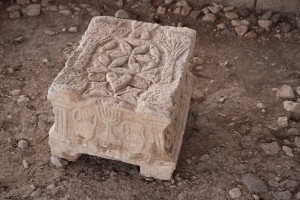 If stones could talk, I would fire many questions at the unique Magdala stone uncovered in 2009 in the recently discovered first century synagogue. But they can’t talk; and so we are left to speculate, with the help of scholars of course. Before the Temple of Jerusalem was destroyed, in 70 AD, the Jewish city of Magdala possessed a very special stone, a precious treasure in their synagogue: their own 4 dimensional representation of the Temple.
If stones could talk, I would fire many questions at the unique Magdala stone uncovered in 2009 in the recently discovered first century synagogue. But they can’t talk; and so we are left to speculate, with the help of scholars of course. Before the Temple of Jerusalem was destroyed, in 70 AD, the Jewish city of Magdala possessed a very special stone, a precious treasure in their synagogue: their own 4 dimensional representation of the Temple.
A curious design is carved into the top central part of the Magdala stone: a 6 petalled rosette, with 6 more petals encircling it. The question is, what does it signify for the first century Galilean Jews? Is it merely a pretty decoration? In the context of the other sacred symbols from the Temple, and considering it was found inside a 1st century synagogue where Jesus very likely taught and preached, many theories have evolved.
The Rosette design consisting of 12 petals could have religious and cosmic significance to the artist and onlookers of the first century. In Oriental and Judaic cultures, the number 12 corresponds to plenitude and completeness. It has been attributed to the government of the cosmos and the completion of a cycle, like the 12 months of the year.
In Judaic tradition, 12 loaves of offering were placed on a showbread table in the Temple each day (LV 24:5). In the history of salvation, the People of God formed 12 tribes of Israel. After Moses had received a message from the Lord he built an altar and set up 12 stone pillars representing the 12 tribes of Israel. Upon that altar, the Israelites offered sacrifice and renewed their covenant with the Lord. (Ex 24)
In Christian tradition 12 stands for the apostles, who represent the leaders of the new covenant established in Christ. They received the mission to go out to all the world and tell the good news. Twelve has represented the manifestation of the Trinity to the four corners of the world (3 X 4).
Yet another theory that has arisen is that it is a symbol of the Greek letter, ICHTHUS, meaning fish.![]() But these 5 Greek words stand for “Jesus Christ, Son of God, Savior.” The combination of these letters placed one on top of the other form a wheel, much like the shape of the rosette.
But these 5 Greek words stand for “Jesus Christ, Son of God, Savior.” The combination of these letters placed one on top of the other form a wheel, much like the shape of the rosette.
However, the most recent theory offered by Hebrew University’s Art Historian, Rina Talgam, identifies the rosette as a symbol of the veil before the Holy of the Holies in the Temple. This interpretation provides the most contextual response, considering that the other images upon the Magdala stone are sacred elements from the Temple. Her final report is awaiting publication, as are all the onlooker of Magdala’s developments.
Now adopted as Magdala’s logo, the question arises: Is the rosette unique to this stone found in Magdala?
Rina Talgamcomments: The rosette was the most popular motif in Jewish art of the Late Second Temple Period and it appears in various artistic media and in diverse contexts: funerary art (ossuaries, sarcophagi, and monumental tomb facades), Herodian palaces and mansions of the rich (mainly on floor mosaics) and even in a few synagogues. The rosette was also well known in non-Jewish contexts during the Hellenistic and Early Roman Periods, but its occurrences were much more common among the Jews. As indicated by Orit Peleg-Barkat from the Hebrew University there is a possibility that the motif (which had been drawn from Hellenistic art) due to its frequent presentations in Jewish contexts perhaps started to be a characteristic feature of the Jewish identity.
Whatever the interpretation and historical use, the rosette now speaks to Jews and Christians alike, a reminder of the relevance of Magdala’s motto: A Crossroad of Jewish and Christian history.
